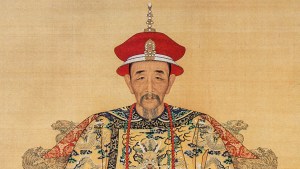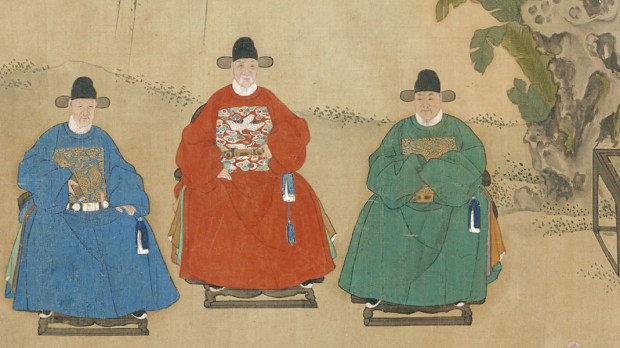A spiritual nature is God’s gift to man, and it is the greatest gift of all, … benevolence, righteousness, social etiquette, and wisdom [the four Confucianist virtues] are all indeed of this nature. These things that God has given us are what we’ve had all along. The Bible calls it morality and Confucius calls it conscience. – Yáng Tíngyún,《天釋明辨》(Light Emitted by Heaven)
Christianity arrived in China through Nestorians in the 6th century, from the Assyrian Church of the East. A Nestorian monk from China, Rabban Bar Ṣawma, met with the first Franciscan pope, Nicholas IV, in 1288. The Franciscans are the first recorded Roman Catholic missionaries to China, with John of Montecorvino establishing a mission in Khanbaliq (now Beijing) in 1294, during the Mongol Yuan Dynasty. He translated the New Testament and the Psalms, and received several thousand people into the Catholic Church.
Jesuits began to arrive in the subsequent Ming Dynasty, bringing Western science and mathematics. They studied Chinese culture thoroughly and took pains to respect social mores, assuming local hairstyles, clothing and etiquette. Chinese intellectuals appreciated this and were eager to learn from the missionaries. Chief among them were Xú Guāngqǐ of Shanghai, and Lǐ Zhīzǎo and Yáng Tíngyún of Hangzhou. These men became known as the Three Great Pillars of Chinese Catholicism (聖教三柱石, literally “the Holy Religion’s Three Pillar-Stones”), a title derived from Galatians 2:9, where St. Paul referred to Sts. James, Peter and John as “pillars.”
Lǐ Zhīzǎo (1565 – 1630) was a government official. In 1610, he fell gravely ill in Beijing. With no family or friends around to care for him, he almost died. However, missionary Fr. Matteo Ricci met him and nursed him back to health at the Jesuit mission established in 1601. During Lǐ’s convalescence, Ricci taught him Western science, mathematics, and Catholicism. Lǐ was soon baptized Leon, and swore, “As long as I live, all that God has given me, I shall put to good use for Him.”
Lǐ gave Ricci 100 taels of gold to build a church in Beijing, and brought the missionaries Fr. Lazzaro Cattaneo and Fr. Nicolas Trigault back with him to Hangzhou for his father’s funeral. In 1625, Lǐ published the Chinese text of the Nestorian Stele, a Tang Dynasty stele which details 150 years of Chinese Christian history. He also translated many works on science and mathematics.
Yáng Tíngyún (1557–1627) was the scion of a devout Buddhist family, appointed to the post of Inspector at the age of 35 after passing the Imperial Examinations. In 1600, he met Fr. Matteo Ricci and began working with the Jesuits on China’s first global atlas. Yáng accompanied Lǐ to his father’s funeral and saw that Lǐ had discarded his home’s Buddhist statues and images. Lǐ had the missionaries celebrate the funeral, with Chinese monk Zhōng Míngrén explaining the rite to assembled relatives and friends.
Yáng was impressed by Lǐ’s faith, and left his concubine a month later, receiving the name of Michael in Baptism. Yáng’s willingness to sacrifice status symbols like his concubine made a great impact on his family and friends; Yáng brought over 100 people to Christ. He invited the Jesuits to use his estate as their base in Hangzhou and purchased land for the first Catholic church in his city, the Cathedral of the Immaculate Conception. Refugees from a 1616 persecution of Christians in Nanjing were moved there, after being housed in Yáng’s and Lǐ’s homes.
Xú Guāngqǐ (1562 – 1633) was also a devout Buddhist and public official, who met Fr. Ricci in 1600, after four years of studying Catholicism. Xú concluded that Christianity was not contrary to Confucianism, but contained what was lacking in it. In 1603, Xú was baptized with the name of Paul, and he catechized his family. He invited Fr. Lazzaro Cattaneo to evangelize Shanghai. Xú and Ricci translated classical Western texts into Chinese – including part of Euclid’s Elements – and Chinese Confucian texts into Latin. Like Cicero, Xú was very interested in agriculture, experimenting with Western-style irrigation and introducing the sweet potato to Songjiang and Shanghai.
During the May 1616 persecution in Nanjing, Xú wrote to the Emperor Wanli following a petition by civil servant Shen Que to expel missionaries. Xú’s “Petition on the Discernment of Real Knowledge” was an eloquent defense, guaranteeing the missions with his own life. He referred to the collaboration between Chinese scholars and missionaries, stating: “This task is the result of putting into practice the divine commandment of love, but it is also a means of promoting prosperity and peace in the country.” Emperor Wanli accepted Xú’s petition, but he spent the next nine years fighting Shen Que’s continued persecution of Catholics.
Xú went on to become the Minister of Rites (禮部尙書), managing matters of culture, education, and foreign affairs, and he was later appointed Deputy Senior Grand Secretary (內閣次輔), equivalent to the current office of Prime Minister of China.
Missionary Fr. Johann Adam Schall von Bell accompanied Xú during his final illness and death. The tomb of Xú Guāngqǐ is the centerpiece of Shanghai’s Guangqi Park, near St. Ignatius Cathedral. The beatification causes of Paul Xú Guāngqǐ and Matteo Ricci are underway, their holy friendship remaining an enduring testimony to their lives of profound faith.

Read more:
The Chinese emperor’s Catholic poetry

